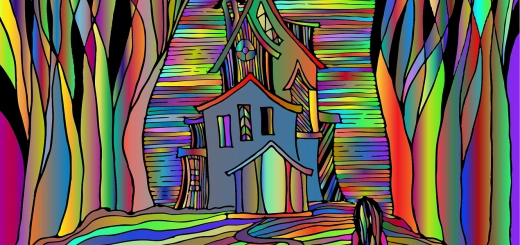The Origins and History of Occult Symbols

Looking for more amazing products? Check out our online store and explore our collection here! Happy shopping!
Before diving in, please note: This post is for informational purposes only. If you’d like to know more about how we approach topics, feel free to check out our friendly Disclaimer Page.
Hey there, amazing readers! 
We’re committed to delivering quality posts, and your support (even just sticking around despite the ads) means everything to us. So, bear with us, and thanks for helping us keep the good vibes rolling. Now, on to the fun stuff!
TRANSLATE BUTTON AT THE END OF THE ARTICLE
Introduction to Occult Symbols
Occult symbols have long been shrouded in mystery and intrigue, captivating the imagination of many throughout history.
These symbols hold deep meanings and are often associated with esoteric practices, mysticism, and hidden knowledge.
From ancient civilizations to modern secret societies, occult symbols have played a significant role in shaping beliefs, rituals, and traditions.
Their enigmatic nature has sparked curiosity and fascination, leading many to delve into the world of symbolism and its profound meanings.
In this article, we will explore the origins, history, and significance of occult symbols, unraveling the mysteries behind these cryptic signs.
Early Origins of Occult Symbols
The origins of occult symbols can be traced back to ancient civilizations such as Egypt, Mesopotamia, and Greece.
These early cultures used symbols to convey spiritual beliefs, cosmic principles, and mystical practices.
One of the oldest known occult symbols is the Eye of Horus, an ancient Egyptian symbol representing protection, royal power, and good health.
In Mesopotamia, the Seal of Solomon, a six-pointed star known as the Star of David, was used as a powerful talisman for protection against evil spirits.
These early symbols laid the foundation for the intricate and diverse world of occult symbolism.
The Role of Occult Symbols in Ancient Civilizations
In ancient civilizations, occult symbols played a crucial role in religious ceremonies, magical rituals, and divination practices.
These symbols were believed to possess inherent power and were used to invoke spiritual forces, communicate with the divine, and channel supernatural energies.
The Ankh, an ancient Egyptian symbol symbolizing life and immortality, was often used in funerary rites to ensure the deceased’s safe passage to the afterlife.
The Caduceus, a symbol of two serpents entwined around a staff, was associated with healing and medicine in ancient Greece, reflecting the connection between the physical and spiritual realms.
Spread of Occult Symbols in Medieval Europe
During the Middle Ages, occult symbols became intertwined with Christian mysticism and alchemical practices in Europe.
Symbols such as the pentagram, the hexagram, and the triquetra were used by alchemists, astrologers, and practitioners of the occult arts to unlock hidden knowledge and harness supernatural powers.
The Knights Templar, a medieval order of warrior monks, were believed to have used occult symbols in their rituals and ceremonies, fueling speculation about their esoteric practices.
As Europe entered the Renaissance period, occult symbolism experienced a revival, with scholars and alchemists delving deeper into the hidden meanings of these cryptic signs.
Renaissance Revival of Occult Symbols
The Renaissance period saw a resurgence of interest in occult symbolism, as scholars, artists, and philosophers sought to uncover the ancient wisdom encoded in esoteric symbols.
Figures such as John Dee, a mathematician and astrologer, and Giordano Bruno, a philosopher and occultist, explored the mystical significance of symbols in their quest for hidden knowledge.
Alchemical manuscripts, such as the "Rosarium philosophorum" and the "Splendor Solis," featured intricate symbols and allegorical images that were believed to hold the key to spiritual transformation and enlightenment.
The Renaissance revival of occult symbols paved the way for the development of modern esoteric traditions and secret societies.
Occult Symbols in Alchemy and Hermeticism
Alchemy and Hermeticism are two esoteric traditions that heavily incorporate occult symbols in their teachings and practices.
Alchemy, the ancient art of transmutation and spiritual purification, uses symbols such as the Philosopher’s Stone, the Ouroboros, and the Emerald Tablet to represent the alchemical process of transformation.
Hermeticism, a philosophical and spiritual tradition attributed to Hermes Trismegistus, explores the hidden teachings of the ancient Egyptian god Thoth through symbols such as the Caduceus, the Emerald Tablet, and the All-Seeing Eye.
These symbols act as keys to unlocking the secrets of the universe and attaining spiritual enlightenment.
Occult Symbols in Freemasonry and Secret Societies
Freemasonry and other secret societies have long been associated with occult symbolism, using cryptic signs, gestures, and rituals to convey esoteric teachings and moral lessons.
Symbols such as the square and compass, the all-seeing eye, and the blazing star are commonly found in Masonic lodges and are believed to hold hidden meanings known only to initiates.
Secret societies such as the Illuminati, the Rosicrucians, and the Ordo Templi Orientis also use occult symbols to signify their members’ allegiance to secret teachings and spiritual truths.
Understand the Powerful Law of Karma and Its Impact – Explore Here!
The use of occult symbols in these organizations reflects their dedication to preserving ancient wisdom and esoteric knowledge.
Modern Usage of Occult Symbols
In the modern era, occult symbols continue to hold a fascination for many, with their mysterious allure permeating popular culture, art, and fashion.
Symbols such as the pentagram, the Eye of Providence, and the ouroboros have become iconic representations of magic, mysticism, and the unknown.
Occult symbols are often used in music, literature, and film to evoke a sense of mystery and otherworldliness, captivating audiences and sparking their imagination.
From tarot cards to astrology, occult symbols remain a powerful tool for self-discovery, spiritual growth, and personal transformation in the modern world.
Controversies Surrounding Occult Symbols
Despite their enduring popularity, occult symbols have also been the subject of controversy and misunderstanding, with some associating them with dark forces, black magic, and malevolent intentions.
The pentagram, for example, has been misconstrued as a symbol of evil and Satanism, despite its ancient associations with protection and spiritual balance.
The all-seeing eye, often linked to conspiracy theories and secret societies, has sparked fears of surveillance and control.
Occult symbols are often misinterpreted and misrepresented, leading to misconceptions and false accusations about their true meanings and purposes.
Decoding the Meaning of Occult Symbols
Decoding the meaning of occult symbols requires a deep understanding of esoteric traditions, mystical teachings, and symbolic language.
Many occult symbols are multi-layered and multifaceted, with each element representing a different aspect of spiritual truth or cosmic principles.
The process of decoding occult symbols involves studying their historical context, cultural significance, and esoteric interpretations.
By unraveling the hidden meanings behind these cryptic signs, one can gain insight into the mysteries of the universe, the human psyche, and the divine realms.
Decoding occult symbols is a journey of self-discovery and spiritual enlightenment, leading to a deeper understanding of the interconnectedness of all things.
Influence of Occult Symbols in Popular Culture
The influence of occult symbols in popular culture is undeniable, with their presence felt in music, art, fashion, and entertainment.
From the mystical imagery of bands like Led Zeppelin and Pink Floyd to the esoteric themes of films like "Harry Potter" and "The Da Vinci Code," occult symbols have permeated mainstream media and captured the imagination of audiences worldwide.
Fashion designers, such as Alexander McQueen and Gucci, have incorporated occult symbols into their collections, adding a touch of mystique and magic to their creations.
Occult symbols continue to inspire creativity, spark curiosity, and evoke a sense of wonder in popular culture, bridging the gap between the seen and the unseen.
Conclusion: The Enduring Legacy of Occult Symbols
In conclusion, occult symbols have a rich and storied history that spans across civilizations, cultures, and time periods.
From ancient Egypt to modern-day Hollywood, these cryptic signs have fascinated and intrigued people seeking to unlock the secrets of the universe and explore the mysteries of the human soul.
The enduring legacy of occult symbols lies in their ability to transcend boundaries, evoke emotions, and inspire creativity.
Whether used in ancient rituals, medieval alchemy, or modern art, occult symbols continue to hold a timeless allure that speaks to the eternal quest for knowledge, wisdom, and spiritual enlightenment.
As we navigate the complexities of the ever-evolving world of symbolism, let us remember the power and magic that occult symbols hold, unlocking the secrets of the universe and unveiling the mysteries of the human experience.

The Enlightenment Journey is a remarkable collection of writings authored by a distinguished group of experts in the fields of spirituality, new age, and esoteric knowledge.
This anthology features a diverse assembly of well-experienced authors who bring their profound insights and credible perspectives to the forefront.
Each contributor possesses a wealth of knowledge and wisdom, making them authorities in their respective domains.
Together, they offer readers a transformative journey into the realms of spiritual growth, self-discovery, and esoteric enlightenment.
The Enlightenment Journey is a testament to the collective expertise of these luminaries, providing readers with a rich tapestry of ideas and information to illuminate their spiritual path.
Our Diverse Expertise
While our primary focus is on spirituality and esotericism, we are equally passionate about exploring a wide range of other topics and niches 

To ensure we provide the most accurate and valuable insights, we collaborate with trusted experts in their respective domains 
Our blog originally focused on spirituality and metaphysics, but we’ve since expanded to cover a wide range of niches. Don’t worry—we continue to publish a lot of articles on spirituality! Frequently visit our blog to explore our diverse content and stay tuned for more insightful reads.
Hey there, amazing reader! 
Check out our store here and take a peek at some of our featured products below! Thanks for being awesome!













